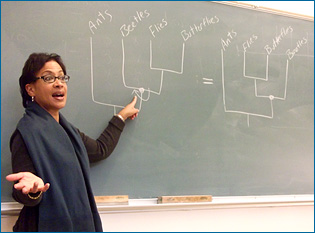by the Understanding Evolution team

Use these quick and simple classroom activities to better develop your students’ tree-thinking skills.
Two-minute trees
- Any time that you or your students give presentations or reports about a particular organism, include a tree graphic that locates the organism on the tree of life. Thinking about evolutionary history can become second nature!
- Put a large graphic of the Tree of Life on your classroom wall (download a large poster with pictures, or a large- or medium-sized poster without). When you refer to a particular organism or group of organisms, point out their location on the Tree of Life and look for the group(s) they are most closely related to. Bonus points to students who can do this too! With older students, you can also use this tree to identify where/when key traits (e.g., aerobic respiration, photosynthesis, having four legs) originated as these topics come up in class. Have your students find pictures of organisms to illustrate the tree.
- At the beginning of your unit on evolution, have your students identify different key features (e.g., polytomies, shared characters, direction of time, common ancestors, etc.) on a tree graphic (download a large poster with pictures, or a large- or medium-sized poster without).
Ten-minute trees
- During a class outing or as an out-of-class assignment, have your students use The Tree Room Field Guide to identify the tree formats represented during a visit to a natural history museum or other informal science institution that has tree graphics (e.g., zoo/aquarium, nature center, etc.).
- Have your students find a tree graphic online and use The Tree Room Field Guide to identify the key parts (root, taxa, common ancestors, etc.). This will help students recognize and interpret these features in unfamiliar trees and understand the diversity of forms that can be used for tree diagrams. (Hint: Try different search terms such as tree, tree of life, phylogeny, evolutionary tree, phylogenetic tree, and cladogram.)
- Have your students search online for three to five trees that include the same taxa or most of the same taxa, and then ask them to trace or highlight the branching patterns to determine which of the evolutionary relationships depicted are the same and which are different. You might like to model this for your students first. A few example trees are provided below. Other easy-to-find clades include insects, dinosaurs, and hominoids.
- Have your students refer to The Tree Room Field Guide to redraw a tree graphic being used in class in one or more different formats. These could be drawn on a chalkboard or whiteboard next to each other or posted on the wall or bulletin board.
- As part of a classroom activity or homework that uses an evolutionary tree, give your students a new taxon to add to the existing tree. Students could discuss what information they would need to place the taxon and conduct some research online to figure out where it should go. Students should then explain their placement in terms of of common ancestry and describe the shared derived characters or lines of evidence that support this placement.
- Using focused informal writing, have your students translate what a tree is showing into a narrative or story. Look for intuitive ideas about evolution in responses, such as the idea of evolution being directed or goal-based, and the use of want- or needs-based reasoning as an explanation for change. Use this is an opportunity to explicitly address these common misconceptions with students.
